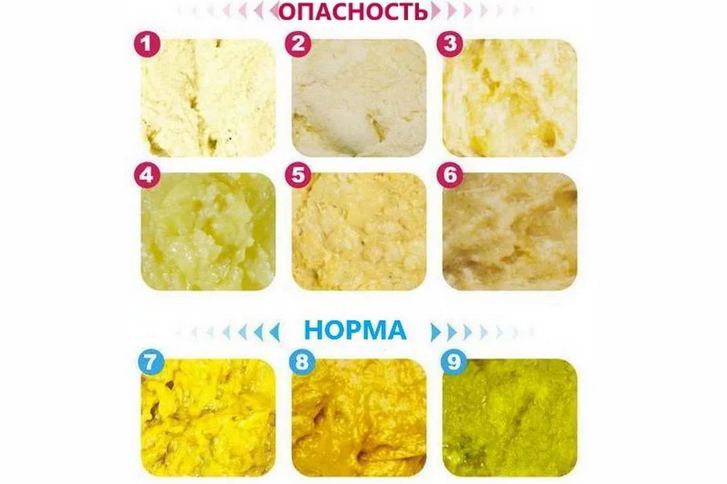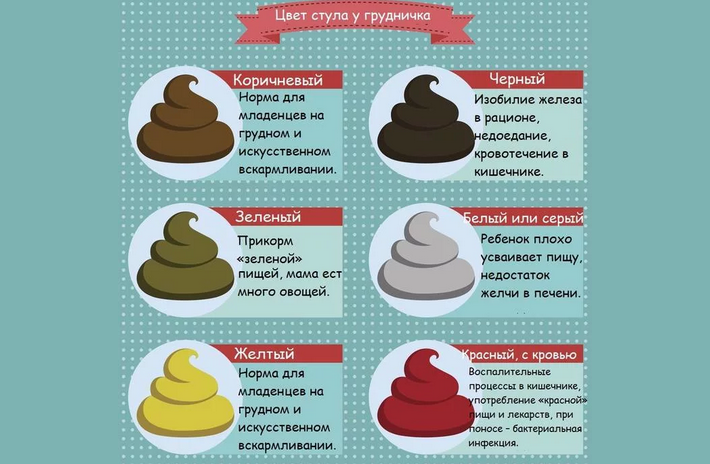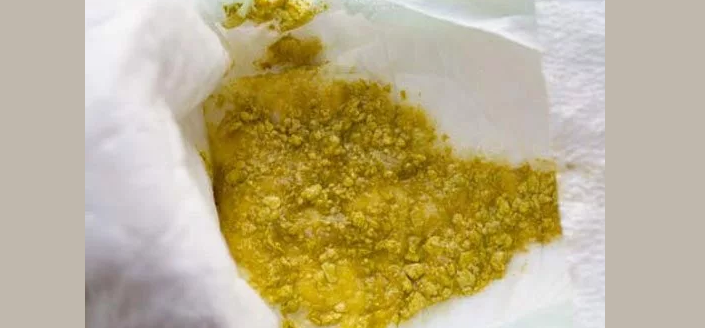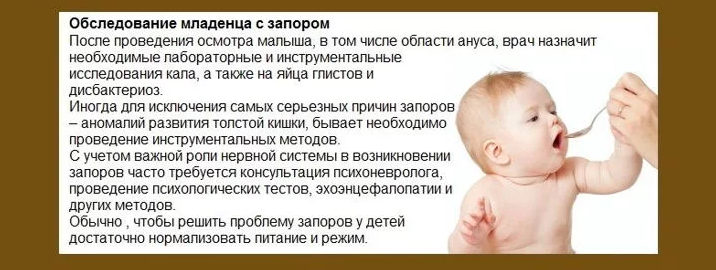This article describes how and when there should be a stool at the baby on artificial feeding.
Contents
- What should be a normal chair for an infants on artificial feeding: color, photo
- When the baby has an artificial feeding chair: how many times a day should a child have a child for months?
- Liquid stool at the baby on artificial feeding: Causes of diarrhea, what to do?
- The baby has a green, greenish stool for artificial feeding: reasons, what to do?
- Gray chair in a child of a baby on artificial feeding: reasons, what to do?
- A thick, hard stool of an infant during artificial feeding: the causes of constipation, delay of a stool in a baby - what to do?
- A stool of infantry breastfeeding - Komarovsky: Video
- Video: Artificial feeding - School of Dr. Komarovsky
The appearance of the baby is entrusted with the education of additional responsibility for parents. The baby’s health, of course, becomes first in the first place, but each time to go to the doctor to find out the causes or danger of new symptoms is not always able to. In order to avoid such situations, it is desirable to know what is the norm. The chair shows the result of the body, which means that this can be understood as its condition. This article describes what a stool should have an artificial feeding, when and how many times a day. Read further.
What should be a normal chair for an infants on artificial feeding: color, photo

Read on our website article about the child's nutrition at 1 year. Of course, you have this age only ahead, but today every mother should know the rules for feeding her baby: what to cook, etc. From this article you will learn what juices can be given to crumbs, dairy products, soups, bread, meat.
Artificial nutrition is not completely capable of repeating the composition of women's milk, respectively, the feces will be different. The first change will be a stronger smell than a child in breastfeeding. The color of feces also depends on the selected nutrition. What should be a normal chair for an infantry feeding of color? The following indicators must be taken into account:
- The norm is a dark orange or natural yellow color.
- The appearance of white interspersed does not indicate the serious consequences of the body. They are formed in connection with the inability of the digestive system of the baby to absorb new food at once.
- You need to pay attention to inclusions similar to cottage cheese. This is a overeating signal.
- Also, excessive portions will talk about excessive stools.
- A bright yellow or orange color indicates problems with the liver, you need to contact a pediatrician.
- Green, for babies older than a week, is also not normal. This is most likely a sign of dysbiosis, rotavirus infection or other diseases. For the first days after birth, the green color is natural.
Above the photo shows what a child’s chair should be. Deviations from the norm:

Mandatory contacting a doctor should be in the dark color of the chair, especially in the presence of blood. She appears if hard feces scratched the passage tracks, most often after constipation.
When the baby has an artificial feeding chair: how many times a day should a child have a child for months?
Children for artificial feeding go to the toilet less often than kids on the chest. When the baby has an artificial feeding chair - how many times a day should a child have a child for months?

- For newborn babies, the norm 6 emptying per day.
- But there are exceptions when the child poop and 10 times a day. If at the same time nothing bothers him, then parents should not worry.
A few weeks after birth, for an infant on artificial feeding, the norm will be one chair per day. For subsequent years of life, this will become the usual frequency.
Liquid stool at the baby on artificial feeding: Causes of diarrhea, what to do?

The liquid chair of the baby on artificial feeding, in consistency, similar to liquid sour cream with a sour smell, means that the child has diarrhea. Other signs are rapid emptying, bloating and skin irritation in the diaper zone. The main reasons for the diarrhea and ways to overcome the disease:
Dysbiosis:
- This is a violation of the balance in the intestinal microflora, often caused by the use of antibiotics.
- In this case, you need to drink prebiotics and probiotics, drugs based on bifidobacteria.
Intestinal infection:
- It is determined by high temperature and vomiting, blood intersperse can rarely accompany.
- This is a common cause of constipation in infants on artificial feeding.
- To solve the problem, you need to consult a doctor who, in turn, prescribes antibacterial drugs.
- It is important to raise immunity to the child. Read about it in the article on the link on our website.
Early introduction of complementary foods:
- It is not advisable to introduce complementary foods up to 5 months, the baby is not ready yet.
- You also need to monitor the reaction of the body to individual products.
Change of mixture:
- It makes no sense to change the mixture if the current one is suitable for the child.
- The new "porridge" is stress for the delicate stomach of the baby.
Teeth:
- Their teething often causes many uncomfortable moments, diarrhea can become one of them.
- In this case, you need to consult a doctor who will prescribe the necessary drugs.
Other diseases:
- Diary can be a symptom of other diseases. These include the congenital impairment of the endocrine system, intolerance to certain types of food or even appendicitis, peritonitis and intestinal inversion.
For any reason, it is necessary to exclude dehydration of the body (let the child drink every 20 minutes), remove dubious products from the diet. With a long diarrhea, start giving more liquid food and be sure to contact a specialist to prescribe drugs.
The baby has a green, greenish stool for artificial feeding: reasons, what to do?

If a green or greenish chair appears in a baby for an artificial feeding at the age of the age of a week, this is a sign of deviations in the body. Below are the reasons and that the parent needs to do:
- In the absence of other disorders in the baby, this is a consequence of a large amount of iron in the diet. There is no danger to this.
- In the presence of foam and sour smell, there is more reasons for concern. This is lactose intolerance. It is necessary to show the baby to the doctor and exclude whole milk from his diet.
- With rotavirus infection, in addition to green feces, an increased temperature and vomiting will be observed.
- The problems of the digestive system will be told by interspersed with thickened blood, and dysbiosis - grains of blood and mucus, the alarming mood of the child and frequent regurgitation. In all these cases, you can not do without medical intervention.
- Not completely digested food particles, mucus in a green chair, speak of immaturity of the digestive system for the introduction of complementary foods.
To cope with the problem of green stool, you need to take the following measures:
- Examine the child at the pediatrician
- A test of blood, urine and feces will indicate health problems
- Change diet: feed more often, but reduce portions
Do not take any action yourself. If problems appear with a stool of crumbs, show it to the doctor. Only he can make the right decision regarding further actions, prescribe an examination and adequate treatment, if necessary.
Gray chair in a child of a baby on artificial feeding: reasons, what to do?

The appearance of gray lumps or grains in feces do not carry danger. But if the feces are completely gray, the cause should be determined. Most likely, it lies in the inappropriate mixture or its change. You should not worry, within a few days the baby’s digestive system adapts and the chair is normalized.
Insufficiently diluted cow's milk can also cause a change in the color of the chair. The bowel movements of a putrefactive nature, dirty gray with the smell of spoiled cheese, may indicate excessive use of protein foods. It is necessary to establish a balance between proteins and carbohydrates, increasing the amount of the latter.
Sometimes the gray color of the child of the baby for artificial feeding signals about problems with the liver, pancreas. It can be such diseases:
- Pancreatitis
- Dysbiosis
- Hepatitis
- Rotavirus infection
The doctor will help to determine the ailment and treatment method that you need to contact with a sharp change in the color of feces and its prolonged preservation. He will prescribe a special diet and bed rest. The child needs to give a lot to drink and gradually introduce vegetable purers, porridge.
A thick, hard stool of an infant during artificial feeding: the causes of constipation, delay of a stool in a baby - what to do?

The absence of a stool in the baby on artificial feeding for more than one day indicates constipation. The child’s behavior is changing, the baby is strongly pushing, blushing, bends his legs to his stomach, squeezes the buttocks and behaves uneasily, cries. So, if a thick, hard chair at the baby with artificial feeding, what are the causes of constipation, delay of the stool in the baby, what to do?
- Most often, this problem arises in connection with the introduction of complementary foods and early teaching to the pot.
Food has a fundamental value for the health of the baby. Constipation may occureleen:
- The composition of the mixture is not suitable for a particular baby. This problem must be solved by trial and error, you need to look at the body's reaction to different mixtures.
- Too thick consistency of the mixture. It can either be diluted or replaced with more liquid.
- The shelf life of the mixture has expired. Be sure to carefully study the date to which the product should be used, and store the mixture according to the recommendations of the manufacturer.
- It is early to enter complementary foods. High calorie content, novelty, density complicate the work of the young intestines. It is necessary to carefully monitor whether the body is suitable for a new product.
- The newborn is malnourished. The chair is delayed in the body due to a lack of feces for emptying, and as a result is compacted. One of the reasons may be too tight on the bottle. The child gets tired earlier than saturated, and refuses to eat further.
- There is not enough fluid. Water must be in the diet of an infant on artificial feeding, from 3-4 months baby tea, from 6 months compote or juice.
- Other causes of constipation can be stressful situations and physiological features. In the latter case, the pediatrician will help.
Here's what else you need to do:
- To cure constipation, you need to feed the baby with vegetable and fruit puree, as they are rich in dietary fiber.
- It is better to exclude dairy products.
- In newborns, poor tolerance of milk protein is common. It is advisable to increase the amount of fluid used.
The following tips will help to establish the trip mode in the toilet:
- Physical activity and mobility.
- Energetic games.
- Stepping movements both when driving a bicycle will be very useful both for overcoming constipation and for the general condition of the body.
- Before feeding, lying on the stomach.
- The circular massage of the abdomen is also suitable for improving the well -being of the child.
- The relaxing effect is given by warm baths.
- The use of glycerin candles will soften the chair and make the process of emptying less painful.
If you do everything right, and the child suffers from constipation, then urgently consult a pediatrician. The doctor will establish the reason, give recommendations and prescribe treatment, if necessary.
A stool of infantry breastfeeding - Komarovsky: Video
Dr. Komarovsky - This is a children's doctor, TV presenter, author of many books about the health of babies and common sense of parents when raising children. He knows all the answers to questions regarding nutrition, upbringing, feeding and of course, going to the toilet of young children. Watch the video about artificial feeding from Dr. Komarovsky, in which he tells his parents about all the nuances, including the baby's chair.







